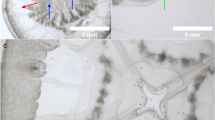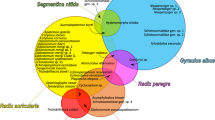Abstract
WHILE engaged in researches on larval trematodes in The Netherlands, I collected specimens of the snail Paludina vivipara Lm. from a dried-up waterway in the vicinity of Houten (Province of Utrecht). In the course of routine examination, no cercariæ having been given off by the snails under laboratory conditions, they were dissected and large numbers of rediæ found which proved, by their structure and measurements, to be the larval stage of an amphistome. This is in itself unusual as P. vivipara is not recorded as acting as intermediate host for this group of trematodes.
This is a preview of subscription content, access via your institution
Access options
Subscribe to this journal
Receive 51 print issues and online access
$199.00 per year
only $3.90 per issue
Buy this article
- Purchase on Springer Link
- Instant access to full article PDF
Prices may be subject to local taxes which are calculated during checkout
Similar content being viewed by others
Author information
Authors and Affiliations
Rights and permissions
About this article
Cite this article
HONER, M. Diplodiscus Species Parasitic in the Snail Paludina vivipara Lm.. Nature 187, 431–432 (1960). https://doi.org/10.1038/187431a0
Issue Date:
DOI: https://doi.org/10.1038/187431a0
This article is cited by
-
A new species of an interesting amphistome Pseudodiplodiscoides Murty, 1970 in Bellamya bengalensis Lamarck, 1882 from water bodies near district Barabanki, U.P.
Journal of Parasitic Diseases (2015)
-
Diplodiscus subclavatus (Goeze 1782) var. Paludinae, var. nov., from Paludina vivipara Lm. in the Netherlands
Zeitschrift f�r Parasitenkunde (1961)
Comments
By submitting a comment you agree to abide by our Terms and Community Guidelines. If you find something abusive or that does not comply with our terms or guidelines please flag it as inappropriate.



